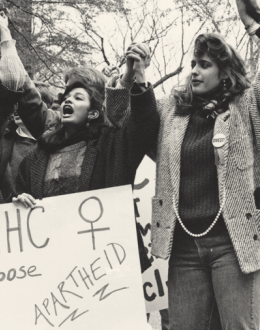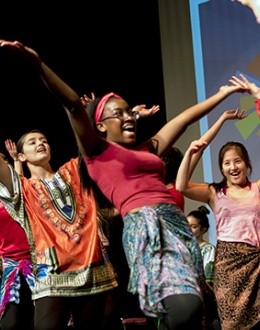Diversity, Equity and Inclusion Timeline
The goal of the timeline is to capture significant events on campus or that impacted life on campus related to diversity, equity and inclusion.
1800s
- 1840s: the first Native American students, Elinor and Mary Boudinot (also spelled Boudinott) attended Mount Holyoke. Furthermore, the first students born outside the United States came to Mount Holyoke from Canada or the Sandwich Islands (now Hawaii).
- 1879–1883: the first African American student, Hortense Parker, Class of 1883, attended and was the first person of color to graduate from Mount Holyoke.
- 1884: the first female member of the board of trustees, Sarah Williston, was appointed.
- 1889: the first student from Japan, Toshi Miyagawa, enrolled in Mount Holyoke.
- 1899: the first male faculty members hired — Asa Kinney in botany and William Churchill Hammond in music.
1900–1920s
- 1910: Trustees vote to abolish secret societies (sororities) on campus.
- 1914: MHC domestic work system replaced by paid jobs for students with financial need.
- 1916: the first students from China, Chi Nyok Wang and Ysu Tsit Law, graduated.
- 1927: W.E.B. DuBois gives lecture on “Negro Literature.”
1950s–1980s
- May 17, 1954: Mount Holyoke College began to racially integrate following the Brown v. Board of Education Supreme Court ruling.
- 1959: Jewish Student Union founded as Jewish Group on campus.
- 1960: Students form MHC Committee on Civil Rights to raise money for African-American students arrested for staging peaceful protests against segregation in southern states.
- 1960: Frances M. Kerr became the College's first African American faculty member when she joined the Psychology and Education Department.
- 1962: United States President Kennedy appointed Mount Holyoke politics professor, Victoria Schuck, as member of Massachusetts Advisor Committee to U.S. Commission on Civil Rights.
- October 20, 1963, Rev. Dr. Martin Luther King delivers address, “Three Dimensions of a Complete Life” at Mount Holyoke.
- 1964: United States Civil Rights Act passed, banning discrimination based on color, race, national origin, religion, and sex.
- 1965: MHC is first women’s college to participate in A Better Chance (ABC) summer program to improve educational opportunities for talented girls from disadvantaged environments.
- 1967: Afro-American Society formed and advocated for increased numbers of African American students at Mount Holyoke.
- December 12, 1968: first sit-in at Mount Holyoke was organized by the Afro-American Society on the steps of Mary Lyon Hall, demanding a separate space for black students to meet.
- January 1969: the space the Afro-American Society acquired burned down (arson was suspected but not proven). As a result, students were given 2 Dunlap Place, which was renovated and expanded in 1972.
- December 1969: the Afro-American Society presented President Truman with a list of demands regarding financial aid, admissions, and other policies.
- 1969: Black studies interdisciplinary program was added to the curriculum.
- 1969: Afro-American Center (now Betty Shabazz House) provides African American students with place for meetings, parties, and other functions.
- February 1970: Five College African American students occupy buildings at MHC and Amherst demanding curricular, admissions, and financial aid changes.
- February 27, 1970: students took over Skinner, Mary Lyon, Kendade, Clapp, Carr, and the Library in response to MHC not creating a Black Studies Program. As a result, a motion was immediately reviewed and passed by the faculty for the Academic Planning Committee to consider the Black Studies proposal.
- 1972: African, African American Studies Program (Black Studies Major) established at MHC
- 1973: First Black Studies major graduates
- 1974: Asian Student Association founded to celebrate and support people of Asian descent at MHC and in the wider community.
- 1975: the Afro-American Society requested a better advising process for students of color, and a counselor specially trained in minority issues, these requests were not provided.
- 1976: La Unidad organization for Latina students is established.
- 1978: Students and faculty stage anti-apartheid sit-in urging the College to divest of stock in U.S. companies doing business in South Africa.
- 1980: Lesbian Alliance organization formed to support lesbian, gay, and bisexual students.
- 1980: Frances Perkins Program established for women of non-traditional age who wish to complete requirements for a B.A. degree
- October 1980: A Forum on Racism and Education was held on campus. Activities included guest lectures, residence hall discussion groups, films and workshops.
- 1982: Women’s studies interdisciplinary program added to curriculum.
- 1982: Under new Third World Requirement students must take courses with non-Western perspective.
- 1982: Writing Center (later Speaking, Arguing, and Writing Center) established to provide students with assistance in writing, reading, and speaking.
- 1983: Civil rights activist and former senator Shirley Chisholm joins faculty as professor of politics and women’s studies.
- 1984: UMMA organization for Muslim students founded as Islamic Cultural Alliance.
- 1985: Board of trustees votes to divest MHC endowment portfolio of stock of companies doing business in South Africa.
- 1985: New campus master plan calls for expansion and renovation of language learning facilities.
- 1989: Kosher-halal kitchen established for use by Jewish and Muslim students.
- 1989: Members of entering class now referred to as “first years” instead of freshmen.
1990s-2012
- 1991: Five College Women’s Studies Research Center established at MHC (first multi-campus facility of its kind in U.S).
- 1993: La Unidad rallied against racial attacks on Latinas and began requesting their own space. President Elizabeth Kennan gave the groups the option of staying in their first space on Morgan Street (which was too small) or sharing 2 Dunlap with Native Spirits. From this, the Eliana Ortega and Zowie Banteah Houses were founded.
- 1995: Native Spirit (later Zowie Banteah) Cultural Center opens for students who identify as Native American or have Native American ancestry.
- 1995: Eliana Ortega Latina Cultural Center opens providing space for classes, lectures, receptions and social events for students who identify as Latina; named after Professor Emeritus of Spanish and cofounder of La Unidad student organization
- 1990s: queer and Asian students of the Lesbian-Bisexual Alliance and the Asian Student Association met with the administration to request their own cultural spaces.
- March 13, 1997: over 100 students rallied against racism and homophobia.
- April 21-23, 1997: students took over Mary Lyon Hall and protested on Route 116 demanding that they receive an Asian and Queer cultural spaces, the institution maintain the need-blind admission policy, hire at least (1) Asian professor while developing a Asian-American Studies program, and rehire the college chaplains.
- 1997: New Community-Based Learning Program links students with local communities through courses, independent studies, and internships.
- 1998: the Asian Center for Empowerment opened.
- 1999: Jeannette Marks House opens as community center for lesbian, bisexual, transgender, queer, questioning, and allied students.
- 2000: SAT (Scholastic Aptitude Test) eliminated as a requirement for admission
- August 2001: Creating a Climate of Achievement for All Students at Mount Holyoke College report completed.
- 2002: CAUSE (Creating Awareness and Unity for Social Equality) student organization established.
- December 2003: Presidential Commission on Diverse Community was established after meetings & activism from students of color (joint effort with MCCL)
- 2003: Center for Global Initiatives established to promote, coordinate, and implement Mount Holyoke’s commitment “to educate all students for careers and citizenship in a global world.”
- April 15, 2009: Annual Hortense Parker Celebration began, an event honoring students of color on campus. This effort was initiated by Ahyoung An '09 and Camila Curtis-Contreras '09.
- Spring 2012: annual Women of Color Trailblazers Leadership Conference began. This was spearheaded by Quanita Hailey FP‘12. It was originally operated under the Women of Color Task Force and is now run by the SGA Students of Color Committee.
2013–2018
- Spring 2013: MCCL Report on Campus Climate
- March 1, 2014: a student of color was arrested in a residential dorm, spurring protests and conversations known as #MoHonest.
- August 2014: Police shooting of Mike Brown in Ferguson, Missouri and #BlackLivesMatter Protests.
- September 2, 2014: President Lynn Pasquerella announces policy on admission of transgender students at Convocation.
- October, 2014: Faculty response to #MoHonest Fall 2014: Faculty meeting to bring BLM conversations into classroom
- Fall 2014: Faculty meeting to bring BLM conversations into classroom
- Spring 2015: Community Dialogue about race on campus.
- July 5, 2015: Five Colleges, Incorporated Diversity Marketing, Recruitment and Retention Initiative (DMRRI) Phase 1
- July 2015: Diversity and Inclusion Report September 2015: Students of Color Committee established under SGA, originally operated as the Women of Color Task Force.
- March 8, 2016: Mount Holyoke Trans Policy Memorandum
- November 16, 2016: students walked out of class to make MHC a #SanctuaryCampus for undocumented students.
- Spring 2017: identity-based dialogues formed for Asian students, trans and gender nonconforming, and Black students.
-
February 2017: In consideration of Black History Month, Mount Holyoke shifted celebrating “FebruMary” from the full month of February to just February 28, Mary Lyons birthday.
- Spring 2017: Shirley Chisholm living learning community for students of African descent and Mosaic living learning community for students of color approved for Fall 2018
- March 27, 2017: Inaugural BOOM: Building on our Momentum Learning Symposium
- August 6, 2018: Kijua Sanders-McMurtry joins Mount Holyoke as its first chief diversity officer


